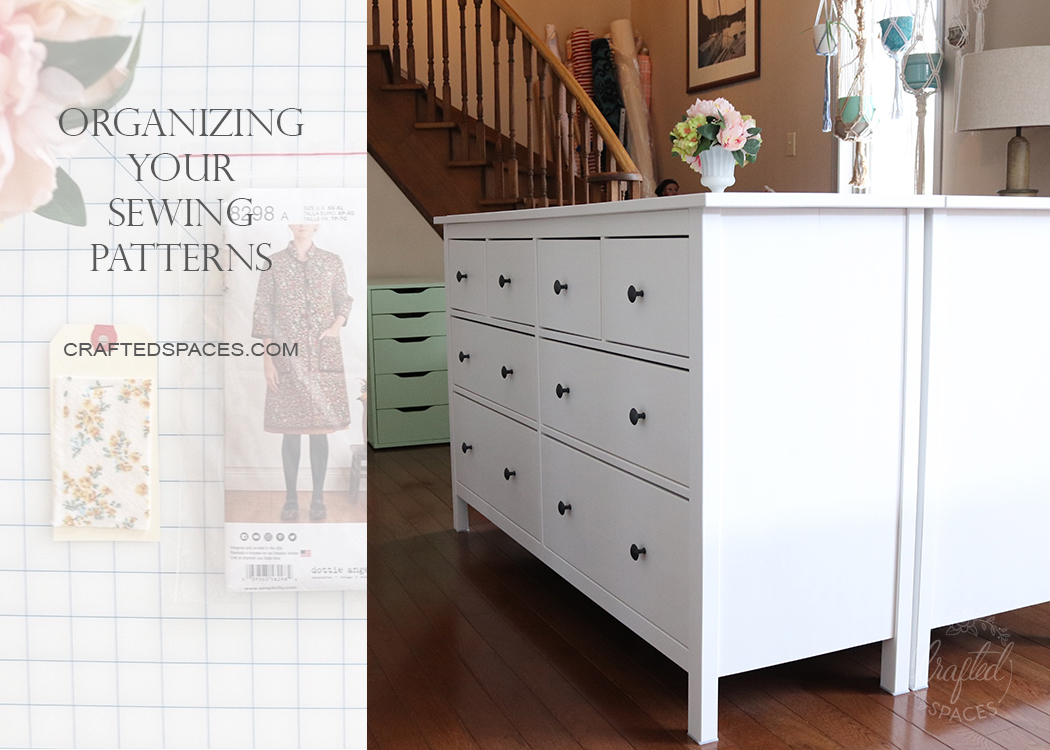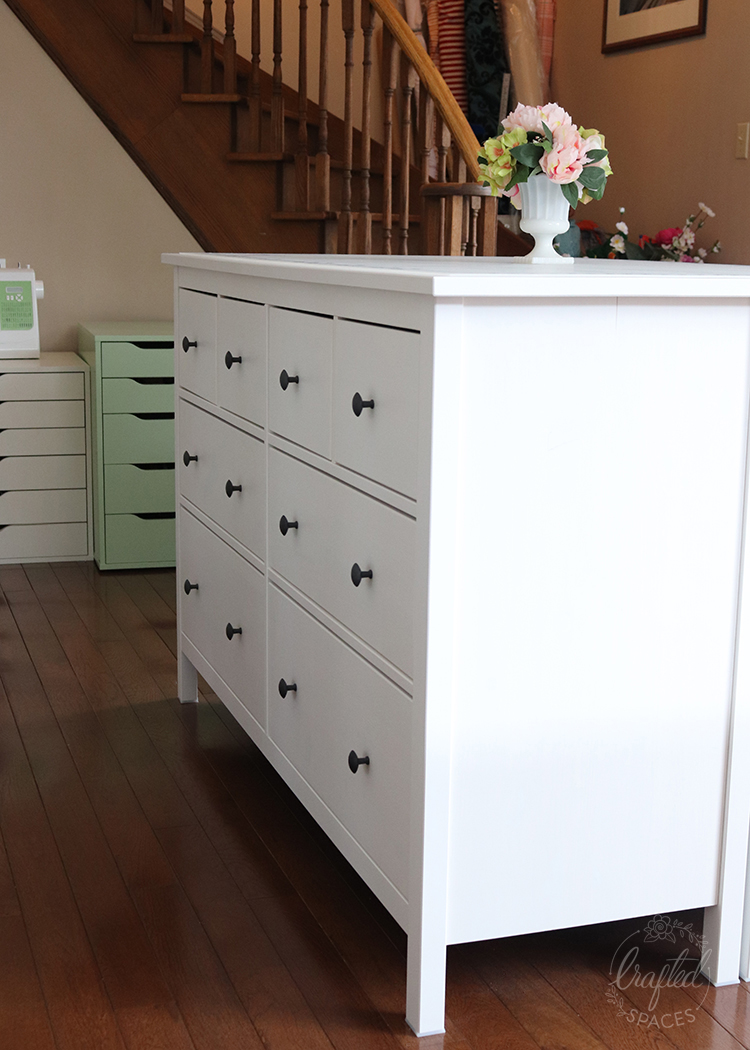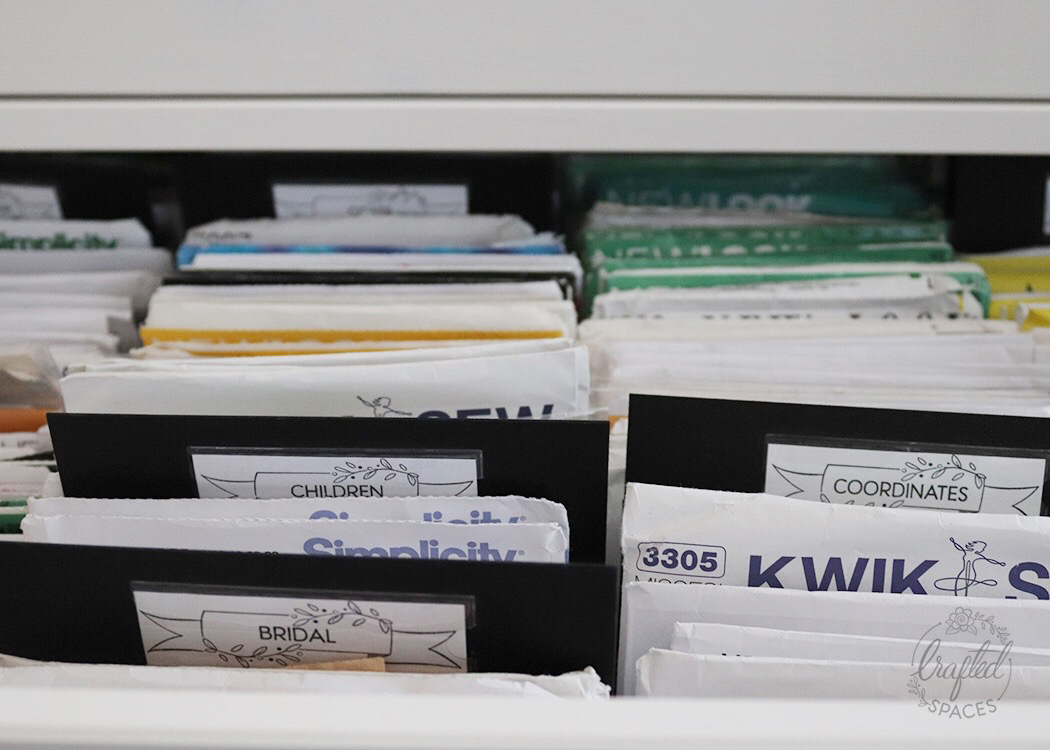Organizing your sewing patterns is one of those tasks that every sewist needs to think about. I have decided to start with this task for our Creative Spaces Declutter and Organization Challenge. I have been using the same system for the past four years, and I needed to make some changes to accommodate our growing pattern stash. We also needed a better system to organize the patterns used in our sewing classes.
The focus of this post is on organizing commercial sewing patterns and does not touch on PDF patterns or patterns I have drafted. There were two small drawers with patterns in my basement craft room and several boxes of patterns in the studio. I also had baskets with patterns spread out in different places in my home. The first step was to bring all the patterns together into one space. The patterns then needed to be sorted, purged and organized into categories.
CREATING AN ORGANIZATION SYSTEM
My approach is to keep things simple, organized and intuitive. I have found that this approach not only gets things organized, but also keeps them organized long term. Take the time to evaluate your current system and assess what works. You should also think about what does not work and why. I also make a list of elements that are important to me and include what I need to function effectively. At the top of my list for organizing the sewing patterns, was the ability to see the patterns at a glance. I also wanted to protect the patterns from ongoing handling.
In the past I used manila envelopes, which worked well when I had a smaller pattern stash. If you make lots of changes to your sewing patterns and you want to keep everything together; then the envelope method can work well. I have found the envelope method a bit time consuming with a larger pattern stash. As my stash grew I was unable to see what I had without flipping through tons of envelopes or a separate binder. Keeping my pattern pieces and the pattern envelopes together works best for me.
SEWING PATTERN DIVIDERS
In the past, I have shared how I used black plastic binders from Dollarama to make dividers for my patterns. They had the right amount of structure, flexibility, and were easy to clean. However, I wanted to avoid working with plastic this time and chose a mounting board I found at Curry’s art supply store. The black “Bainbridge Letramax” sheets are 14″ x 20″ and are .95mm thick. I cut the sheets into smaller 6″ x 9.5″ sheets and was able to make four dividers from each mounting board. I wanted the labels to be attractive and uniformed, so I created the labels in Adobe Photoshop, and used our Crafted Spaces decorative banner. The labels were printed on white card stock and was cut to size using a paper cutter. The label holders were from the Dollar Tree; however, you can find similar label holders at Dollarama.
Over the years, I have found that separating my patterns into categories is the best system for me. The categories are based on the pattern categories listed on the pattern manufactures websites; such as the ones on Vogue patterns. I therefore made 28 dividers based on these categories and I reused my old plastic dividers to separate the patterns for our sewing classes. I then further organized the patterns in each category alphabetically by pattern brand (Burda, Butterick, Kwik Sew, McCall’s, etc.) and then numerically based on the pattern numbers.
PROTECTING YOUR SEWING PATTERNS
I use plastic sleeves (ziplock bags and resealable bags) on some patterns. These plastic sleeves make it easy to see each pattern, while keeping them protected from handling. If I am working with a pattern or have used it for a project, I can include a fabric swatch along with other details about the project. I can also note any changes I have made to the pattern inside the plastic sleeve. The 7″ x 9″ ziplock bags are large enough for most of my patterns. The patterns that are meant for resale or giveaways are placed in resealable plastic bags. The resealable bags are available in different sizes and are a little bigger than the patterns, so they fit perfectly. This method means I do not need to photocopy or cut my pattern envelopes. I also do not have to separate the pattern pieces from the pattern envelope.
SEWING PATTERN STORAGE
How and where you store your sewing patterns can depend on the type of patterns you have and the size of the pattern envelopes. Patterns can be affected by moisture, so it is best to store sewing patterns in a cool dry place and away from direct sunlight. You also want to make your patterns easily accessible. Filing drawers, bankers boxes and other storage containers can all work effectively. I suggest you measure your patterns and decide how much space you will need. I have stored the patterns in the four large drawers of our new workstation. The new workstation was created by facing two Ikea “Hemnes” eight drawer dressers back to back. Each dresser has lots of storage for sewing and craft supplies. This solution works well for the studio, because we needed lots of storage space and a larger work surface that could accommodate our pinnable cutting mat.
I hope that sharing my process for organizing sewing patterns has been helpful and will spark some ideas for organizing your sewing patterns. Organizing is an ongoing process, so I am guessing that I will make some changes in the future. I am very happy with the results, and I think it will work well for some time. It is important to be flexible and open to change, as new patterns will be added in the future. There are many ways to approach organizing your sewing patterns and new ideas are always available. With some planning and the right storage solution, you can find what works best for you. Let me know what you think of this system. I also welcome your suggestions for any improvements and remember to share using #csgetorganized.
UPDATE
- Creative Space Declutter and Organization Challenge
- Organizing Your Fabric Stash
- How To Organize Yarn
- Organizing Your Craft Supplies
- Studio Tour







Do you still have the Simplicity 8298 Dottie Angel coat pattern pictured above? If you do, would you be willing to sell it? I have the matching one for kids and am on a desperate hunt to find the adult mate.
I do have the pattern, but unfortunately it is not for sale. It was a challenging pattern to find. I found it on Amazon. It was some time back so I am not sure if it is still available. I’ll let you know if I come across it again. Sorry!